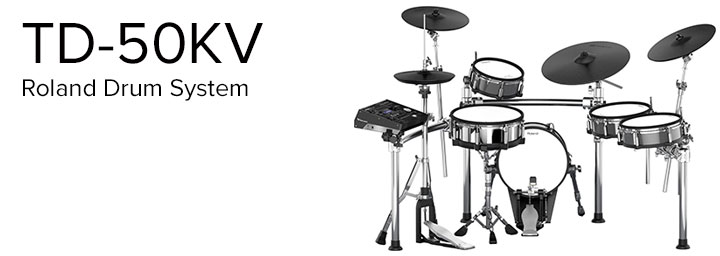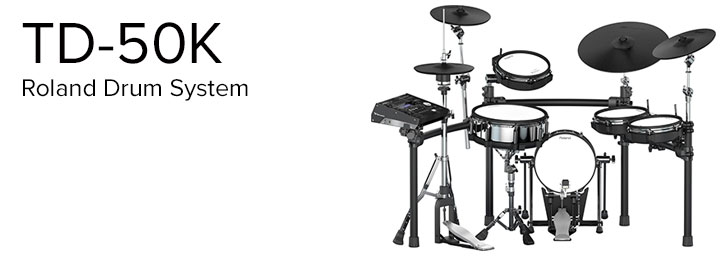Let’s look at how to enhance the TD-50 snare sounds, resulting in clear and snappy sounds that sit great in any mix.
The TD-50 snare is the most varied part of the drum kit and gets its name from the rattling set of wires underneath it.
These wires are known as the “snares”, which are held against the bottom head under tension by the snare strainer and result in a bright and snappy sound that cuts through.
From thin brass piccolo to medium depth aluminium or deep maple wood, the right snare can transform the entire kit sound.
In order to suit any style of music they may be asked to play, studio drummers frequently take a range of snare drums to a recording session.
Here are just some of the many ways to enhance snare sounds in the flagship Roland TD-50 V-Drums.
Contributed by Simon Ayton for Roland Corporation Australia
1. Change the Snare Drum Shell Depth
Changing shell depth is a great way to transform your TD-50 snare sound to help it sit nicely in the mix.
Piccolo snare drums generally have a depth of only a few inches, whereas a typical steel rock snare may have a depth of 6 ½ inches or more.
While a piccolo snare will give a great crack and cut through well, it may need some mid-range equalization to make it sound larger, with more thump.
In the TD-50, the physical limitations are removed so that you can increase the depth of any snare drum (including a piccolo drum). This results in a much bigger sound while maintaining the bright crack so it can cut through a dense mix.
Finding your ideal sound is fun and allows you to personalize what is arguably the most important drum of the kit.
[INSTRUMENT] | F1 (INST) | R2 (Shell Depth) | 1-30
1 | No shell. Bright and thin sounding. Very responsive.
6.5 | Standard depth. Medium to heavy body with a balance of high and mid frequencies. Good responsiveness.
12 | Deep marching drum. Boomy and powerful. Less responsive.
Try: 10.5.
2. Change the Snare Head Type
Coated heads are the standard with snare drums giving a rounded and controlled sound.
In order to create more cutting sounds, many drummers and engineers throughout history have experimented with other head types, especially in the studio.
A pinstripe or clear head will give you more attack and also increase brightness, without the need for adding EQ.
The same is true in the TD-50 module where changing the head type will result in subtle but very effective variation to the sound.
[INSTRUMENT] | F1 (INST) | R3 (Head Type) | Clear-Pinstripe
Clear | Bright and resonant.
Coated | Darker attack and more controlled overtones.
Pinstripe | Aggressive attack with exaggerated Mid EQ and controlled sustain.
Try: Coated.
3. Change the Snare Tuning
Tuning the snare to sit well with the music is one of the most important ways to enhance the TD-50 snare sound.
Some drummers like to use a deeper snare tuned right up, while others prefer a thinner snare tuned down for a more comfortable and forgiving playing feel.
What’s right for you comes down to personal taste and also what fits the music.
Unlike acoustic drums, tension and pitch are independent of each other with V-Drums.
This is a major advantage as far as sound creation goes.
Adjust your V-Drums pad to a tension that’s comfortable and then choose a sound in the module that fits.
Some producers tune the snare to match the key of the song, while others tune it to cut through a wall of guitars and stick out in the mix.
The TD-50 allows you to have different tunings for the head and rim of the snare, simply by unlinking them via the “H&R” (head & rim) button.
Separate tuning for TD-50 snare drum head and rim is very useful for creating a snare with higher pitched rim-shots than the snare head itself.
Use it for added excitement in choruses for example, or for simulating two snare drum setups.
[INSTRUMENT] | F2 (BASIC 1) | R1 (Tuning) | -100-+100
4. Modify the Tonal Character and Resonance of the Snare Drum
Muffling is a way of controlling the ringing or sustain of a drum, but it also changes the tonal character of the drum.
Lay a tea towel over a snare and hit it to hear just how dramatic the difference can be.
This technique was used frequently by Ringo Starr and was put to great use on The Beatles’ Come Together.
Applying tape and donut muffling rings are common ways of muffling down a drum to kill any unwanted ringing.
Just like with an acoustic drum, in the TD-50 you can choose several different kinds.
It’s a good idea to try these settings in a musical context as too much muffling can stifle a drum performance.
Overtones are directly affected by muffling and head tension, but its adjustment is offered in the TD-50 as a separate control to help you to fine tune the overall snare sound.
[INSTRUMENT] | F2 (BASIC 1) | R2 (Muffling) | OFF-Donut2
OFF | Full ring/sustain and overtones.
TAPE2 | Controlled ring and moderate tonal change.
Donut2 | Maximum tonal change and minimum ring.
Try: TAPE2.
[INSTRUMENT] | F2 (BASIC 1) | R3 (Overtone) | -5-+5
-5 | Minimum overtone.
NORMAL | Balanced overtones.
+5| Maximum overtone.
Try: +1
5. Change the Snare Strainer Character and Tension
The snare strainer is what gives the snare drum its uniquely bright and buzzing sound, which helps it to cut through the mix.
You can control several parameters for the strainer in the TD-50.
Snare strainers come in many widths and are made from several different materials, each with their own characteristics. These heavily influence the total snare sound and the playing feel of the snare.
Wider strainers offer a more pronounced bottom snare buzz sound, but they also shorten the decay of the snare drum, due to their surface contact and the muffling effect on the drum itself.
The strainer tension adjustment in the TD-50 is used to control the length of the snare buzz.
The wire level is like adjusting the volume of the bottom microphone level, as would be done in a typical multi-microphone drum recording session. Increase snare buzz when you want more sizzle and clarity from the snare!
Lower strainer tensions increase the body and resonance of the snare sound.
Lower snare strainer tensions can work well for Blues and Jazz, whereas tighter tensions can sound punchier and more controlled, which can work better for faster tempos or busy mixes.
[INSTRUMENT] | F3 (BASIC 2) | R1 (Strainer Adj.) | Loose1-Tight3
LOOSE1 | Most sustain and snare buzz.
MEDIUM1 | Controlled sustain and moderate snare buzz.
TIGHT3 | Shortest sustain and buzz.
Try: LOOSE2.
[INSTRUMENT] | F3 (BASIC 2) | R2 (Wire Type) | TYPE1-TYPE3
TYPE1 | Narrow strainer with less buzz.
TYPE2 | Medium width strainer with balanced buzz and sustain.
TYPE3 | Wide strainer with exaggerated buzz and less drum sustain.
Try: TYPE2.
[INSTRUMENT] | F3 (BASIC 2) | R3 (Wire Level) | -4-+5
Try: -1.
6. Adjust the Close & Ambient Microphone Mix
Multiple close and ambient microphones are used in the recording sessions for V-Drums sounds.
You can adjust the blend of these, for a closer or more distant sound in the TD-50.
With both the overhead and room sound on minimum settings, you are hearing the close-miked, mono-like sound from an inch or closer away from the drum. This not how drums are generally heard by the player.
In a typical drum kit setup, the kick is at shin height, the snare is at waist height and the cymbals are at head height.
Because of this, the illusion of a balanced kit has to be achieved through the careful balance of mic positioning and volume.
As you increase the overhead sound, you will hear the stereo image expand, while the sense of depth and distance from the drum will increase, putting you more in the player’s position.
Increasing the room microphone level will give you a bigger and richer drum sound.
[INSTRUMENT] | [PAGE DOWN] | F2 (ELEMENT) | R1 (Overhead) | R2 (Room)
Try: Overhead +4 | Room -2.5.
7. Modify the Attack and Sustain of the Snare
One of the simplest yet most powerful tools in the TD-50 is the transient tool.
With this one screen, you can dramatically modify the attack and sustain characteristics of any of the acoustic style factory sounds of the TD-50.
Using the transient tool, back the attack and release right off for minimal stick attack, with a quick decay.
This will give a more classic, rounded sound.
Going the other way, you can increase the attack for more stick and initial snap and increase the release for more tail of the sound.
The reult of which will be a more aggressive rock sound, with the desirable snap and hold of a compressor but without the “pumping” and “breathing” side-effects.
[INSTRUMENT] | [PAGE DOWN X2] | F4 (TRANSIENT ON) | R1 (Time) | R2 (Attack) | R3 (Release)
Gain: For overall volume adjustment.
Try: Time 3 | Attack 77 | Release 32.
Recommended Article: How to Record the Roland TD-50 V-Drums



